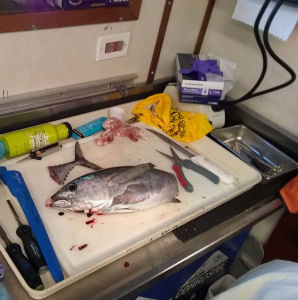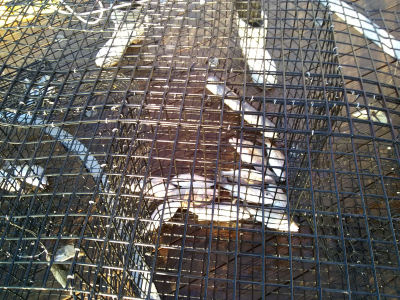Red Tide Water Quality Assessment Research Cruise
Cruise Updates
Friday, October 12 Cruise Update from R/V Walton Smith
We left Miami at 8:30 this morning and did 3 stations off of the safety valve entrance to Biscayne Bay. All instruments are working well and we did an additional set of profiles to calibrate the VIIRS satellite when it passed overhead at 2:10 this afternoon. On our transit down to Key Largo Casey caught a blackfin tuna, that Micah from FWRI sampled for brevetoxin, mercury, and otoliths to age. We are currently approaching our station on Molasses Reef, located on the reef tract offshore of Key Largo, where we will be sampling phytoplankton, zooplankton, and nutrients.
We have modified our cruise plan due to the red tide being detected in the channel to the west of Key West. We will be sampling the Key West channel overnight and tomorrow we will be sampling water quality and surveying fish populations as we transit from Key West to Marco Island.
As expected, we have not encountered visible signs of red tide as we have transited from Miami to Key Largo.
Saturday, October 13 Cruise Update from R/V Walton Smith
We sampled our Marine Biodiversity Observing Network Stations at Molasses Reef, Looe Key Reef, and Western Sambo Reef today. At daybreak we were near western Sambo Reef and had bonito, blackfin tuna and other fish jumping all around the research vessel. We caught a cerro mackerel for the FWRI fish and wildlife health researchers to sample. We then went through Key West and began sampling for red tide. Devin got the flow-cam working and just north of Key West we saw a possible, but not confirmed Karenia cell.
We continued sampling as we headed North-Northwest from Key West. At our station 30 miles NNW of Key West and about 60 miles SSW of Marco Island in 12 meters of water, we began to see stratification in the CTD profile. Warmer, fresher water up top and colder, saltier water at the bottom. The bottom water also had decreased oxygen. This lower oxygen bottom water continued all the way to station 30.
We set our first fish camera traps and ROV surveys just before sunset offshore, appproximately 50nm southwest from Marco Island. Brett was able to see lane snapper and a few other fish in the camera trap and the ROV survey found some sponges and a few fish. After dark, we flew the ROV in an areas where Casey’s fishing colleagues had reported red tide and fish dying a few weeks ago. On this flight we saw smaller fish and a moray eel. We have heard from Casey’s fishermen contacts that it appears Michael may have blown the redtide offshore. Thus far, we have not seen any dead floating fish or dead fish at the bottom in the ROV surveys.
Sunday, October 14 Cruise Update from R/V Walton Smith
As we continued our line from 50 miles southwest of Marco Island towards Marco Island, we continued to see stratification with lower oxygen waters on the bottom. The oxygen levels were under 4 mg/l in the water column deeper than 3m from the surface. Then, when we started the Caloosahatchee line we had oxygen levels below 2 mg/l at the station 20 miles southwest o f Ft. Myers. The conditions got better as we approached Ft. Myers with higher oxygen levels on the bottom.
Once we started setting the camera and z-taps for fish sampling 10 miles west of Sanibel Island, the water started to look like it potentially contained red tide and the attached satellite image showed a high chlorophyll a patch in this area. The attached CTD cast showed several layers of stratification with a deeper, intense chlorophyll max and the oxygen levels on the bottom are below 2 mg/l.
The z-traps we set had a school of tomtates that appeared to have soft stomachs and livers. Thus far, we have only seen 2 dead eels floating on the surface, no other dead fish, dead marine mammals, or dead turtles have been sighted on our cruise. We did see a healthy-looking loggerhead near Ft. Myers today.
We started the transect off of Redfish Pass, where we are doing our intense red tide sampling given the information from the satellite and our observations at the camera traps.
Monday, October 15 Cruise Update from R/V Walton Smith
We surveyed the transect off of Redfish Pass and Gasparilla Pass overnight. As the satellite from Dan Otis suggested, there is a phytoplankton bloom that was most intense in the nearshore stations off of Redfish Pass. There is stratification at every station with saltier, cooler, low oxygen water on the bottom and a narrow peak in chlorophyll at the thermocline. We took all of our different sample types at RP1, RP3, and GP5 to obtain an offshore-onshore transect. We hoped this would give us a transect across the bloom and it appears to have done so. The attached CTD profiles are from station RP3 in the dense part of the bloom and GP5, which is the most offshore station and showed little evidence of the phytoplankton bloom, but still had strong stratification in temperature and salinity.
Around daybreak, we started recovering the fish traps. The traps have had mostly tomtates and white grunts, but did have a single small red grouper and a spadefish. We have been deploying camera traps and z-traps all day working from the area near the peak of the bloom to the offshore.
The z-traps we set had a school of tomtates that appeared to have soft stomachs and livers. Thus far, we have only seen 2 dead eels floating on the surface, no other dead fish, dead marine mammals, or dead turtles have been sighted on our cruise. We did see a healthy-looking loggerhead near Ft. Myers today.
We spotted a couple healthy-looking loggerheads today and saw a blow from an unidentified whale species. We are about to deploy our last trap and then try one of Casey’s fishing spots to see if we can increase the diversity of the fish we are sampling.
Tuesday, October 16 Cruise Update from R/V Walton Smith
We decided to change the cruise plans based on the satellites and information from FWRI and headed north overnight to sample off of Pinellas county today. We cut the stations off of Sarasota and Venice, opting instead to survey off of Tampa Bay this morning. We started out in clear water, but did see stratification and an increase in phytoplankton at the bottom in the attached TB5 profile, which was about 25 miles west of the Tampa channel. About 3.5 miles off of Madiera Beach we began to see dead fish and reddish colored water. The flow-cam showed some Karenia cells in the area, see attached image. We collected dead look-downs, spadefish, ladyfish, mullet, catfish, and a black drum for processing by Micah and Eli to look for brevetoxins in their tissues. The CTD profile at our closest station to land, also attached, was quite different with a large fluorescent peak at the surface. We continued to sample this area and were still finding Karenia cells in the flow cam 10 miles from land. We are now heading north to sample off of Clearwater.
On a positive note, we had a pod of spotted dolphins riding the bow at 9:30 last night as we were beginning our transit to Tampa and got decent goPro video of them.
Wednesday, October 17 Cruise Update from R/V Walton Smith
The sampling off of Clearwater brought us more likely red tide. Parts of the bloom off Clearwater may have had more of a mix of Trichoidesmium with Karenia brevis. We found more fish kills, but no species of note and it was an older kill with degraded fish only and not as many as we saw yesterday. In fact, we saw no target species and the fish were so degraded that we couldn’t sample them. We sampled four CTD stations heading west from Clearwater then went south to pick up another station, TB9, offshore on our last transect (see attached cruise track). We went to TB9, because TB8 we thought was far enough offshore, but there were still some red tide organisms in the flow cam images.
The profiles in the red tide off of Clearwater looked the same as off Madeira Beach with the bloom right on the surface at high concentrations. At the furthest offshore station, CW4, we had returned to a well-mixed water column with low chlorophyll. Throughout both transects off of Pinellas County the dissolved oxygen was much high at the bottom than off of Sanibel Island.
Casey has been keeping us updated with devastating reports from the southwest Florida fishing community as stone crab season opens. One crew pulled 800 crab traps for 7 pounds and another pulled 400 traps with no crab off of Boca Grande.
We may not have internet until Friday, so I may not be able to send out another update today as we do fish camera work off of Everglades City or tomorrow as we survey water quality off of the Everglades.
Friday, October 19 Cruise Update from R/V Walton Smith
We are on our way back to Miami now after a very successful research cruise. Everyone aboard on both the science and ship’s crew was excellent and worked hard and collaboratively to make sure we got the best information possible to try to better understand red tide on the west coast of Florida and its impact on the ecosystem.
As we continued to survey further south from Marco Island we again found low oxygen bottom water associated with a colder, saltier bottom water mass. This was located by the camera and z-traps about 25 miles southwest of Marco Island. As displayed in the attached CTD plot, this low DO area had similar stratification in temperature, salinity, and oxygen, but the chlorophyll did not have a narrow peak by the pycnocline (change in temperature and salinity) as we saw to the north. Instead it was a much smaller increase throughout the bottom layer. Despite the lower oxygen conditions, there were lots of fish in the z-trap. As we headed east to sample our typical stations off the Everglades, the low oxygen water was not present. When we went further west on Thursday to do another set of fish cameras and traps, we found the likely edge of the low oxygen zone. These stations were about 40 miles west of Shark River and 13 miles southeast of the low dissolved oxygen station from Wednesday. There was no change in salinity with depth and only about 3/4 of a degree Celsius cooler water at the bottom, but the oxygen was still down to less than 4 mg/l. This low oxygen water was not present at the station 17 miles south, where we found a well-mixed water column.
We are currently steaming up Hawk Channel on our way back from a successful cruise with the dewars, feezers, and refrigerators filled with samples and our computers filled with data. Now the work starts of analyzing the data and putting it all together to figure out exactly what the environmental conditions were in the area and how these impacted the red tide and the ecosystem. We also hope this is just the beginning of a more robust observational program for red tides on Florida’s west coast. We will have a phone call next week to start collaborating on data analysis and interpretation.



















